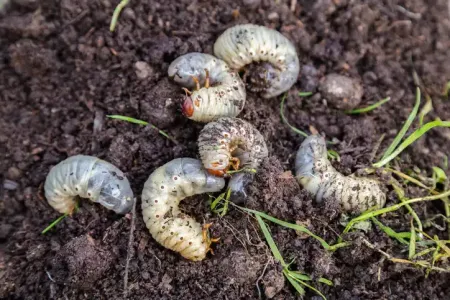
Grub Control Guide: How to Spot, Treat, and Prevent Lawn Damage
Don’t guess at brown spots — test. A simple 1 ft² turf check tells you whether grubs are present and whether treatment is justified; preventive products work only if applied before eggs hatch, while the most reliable curative control is during the late-summer → early-fall feeding window. Treat based on confirmed counts and timing, not on fear or anecdote.
What are “white grubs” and why do they matter
White grubs are the C-shaped larvae of scarab beetles (Japanese beetles, June beetles, masked chafers) that feed on grass roots and weaken turf. Heavy infestations cause turf to brown, become spongy, and pull up easily; animals digging in the yard are often following grubs as a food source. Because a brown lawn can be caused by drought, disease, or compaction as often as pests, diagnosis matters before any treatment is applied.

How to check for grubs — the 5-step spot test
- Cut or lift a 12" × 12" square of turf with a flat shovel in the suspect area.
- Pull back the turf and inspect the top 2–3 inches of soil for C-shaped white larvae.
- Count all grubs in that square and record the number.
- Repeat the test in 3–4 locations (sun, shade, near drains) to detect patchiness.
- Use the counts — don’t guess — when deciding whether to treat.
Purdue University extension guides use this exact sampling approach as the basis for treatment decisions; sampling multiple spots avoids overreacting to a single unlucky hole.
Timing: why spring prevention and late-summer/fall curative windows matter
Preventive insecticides must be applied before eggs hatch, which typically occurs in late spring to early summer in many regions. Curative controls are most effective when larvae are actively feeding near the soil surface — generally late summer into early fall for cool-season lawns — because younger grubs are easier to control and the timing aligns with turf recovery before winter. NC Extension specialists emphasize this difference: the wrong product at the wrong time simply wastes money and can reduce effectiveness.
Treatment options — realistic pros and cons
- Preventive systemic products: good residual control when applied at the correct time, but ineffective if used after eggs have hatched.
- Curative contact insecticides can knock down existing populations if applied properly and watered in to move the product into the root zone.
- Biologicals (beneficial nematodes, milky spore): possible but condition-dependent; nematodes need correct soil temperature and moisture, and milky spore is species-specific and slow to establish.
No single product is a magic bullet. We recommend choosing a strategy based on confirmed sampling, local species, and timing rather than fear-driven blanket spraying.
Thresholds — when treatment is truly justified
Practical thresholds are the difference between an evidence-based program and unnecessary pesticide use. The Purdue extension suggests decision thresholds of roughly 5–10 grubs per square foot, depending on turf condition; some species and well-irrigated turf can tolerate more before damage appears. Use counts plus turf stressors (drought, compaction) to decide — don’t let a single torn-up spot or wildlife activity be the only reason to spray.
Wildlife digging and non-chemical options
Skunks, raccoons, and birds often indicate grub presence, but digging alone isn’t proof. Perform the 1 ft² checks in dug areas before treatment. If counts are low, cultural fixes (such as adjusted irrigation and spot repairs) and monitoring are more effective than broad insecticide applications.
When to call a professional (and what to expect)
If you’re consistently finding grubs across multiple areas of your lawn, seeing large patches of dead turf, or struggling to time treatments correctly, it’s time to bring in a professional. A qualified provider should share their inspection results with you, explain which species are present, discuss timing, and offer grub control treatment options ranging from biological to chemical — never pushing an unnecessary blanket spray.
At Dynamic Lawn & Landscape, our approach is straightforward: we provide you with clear answers backed by data. We document grub counts, identify species, and provide a straightforward, timed recommendation so you know exactly what your lawn needs — nothing more, nothing less. That way, you can decide with confidence whether treatment is necessary, knowing you’re guided by facts, not fear. Call our team today to request services or follow up with questions.
